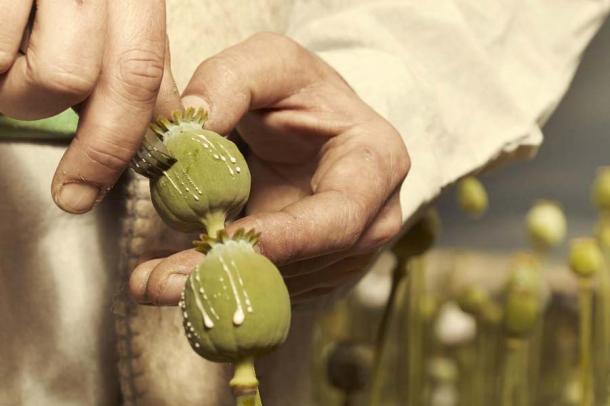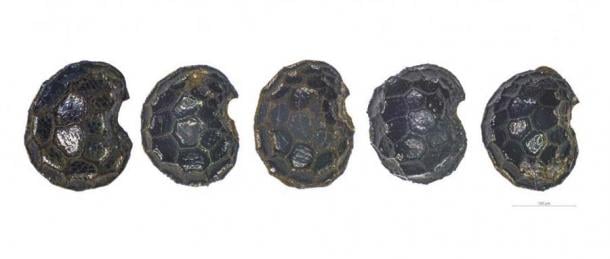When it comes to plants with powerful medical applications Asia can be called the ‘traditional home.’ However, this is not the case when it comes to opium poppies, for new research has shown their domestication happened around 5000 years ago in the Swiss Alps.
The Zürich Opera House was built in 1891 at the Sechseläutenplatz in the Swiss city of Zürich. Now, a new study has shown that 5500 years ago, where the Opera House’s underground garage now stands, there existed flowing fields of opium poppies. Amidst these blazing colorful fields of poppies ancient farmers applied their emerging crafts of cultivation, but a long outstanding archaeological mystery is to what extent these agriculturalists affected, altered, or enhanced the domestication of what is today one of the most used medical plants.

Detail of cutting poppy heads with a knife to harvest opium latex . ( Couperfield /Adobe Stock)
Opiates are substances with active ingredients derived from opium poppy plants ( Papaver somniferum L. ) including morphine and codeine. While in modern culture even these words bring dark connotations of abuse and addiction, in the ancient world, the poppy plant was not only a valued medicinal plant but an important food source. Now, researchers at the University of Basel and Montpellier have analyzed seeds gathered from where the Zurich Opera House underground garage now stands and they have determined prehistoric farmers throughout the Alps had at least a hand in the domestication of opium poppies.

Flower and capsule of the opium poppy. ( Raül Soteras, AgriChange Project )
Popping an Ancient Poppy Porridge Together
The team of researchers have published a new paper in the journal Scientific Reports which explains that besides being a provider of opium and opiates, “poppy seeds can be ground up and used to make cooking oil and porridge.” However, the answer to the question “where was the poppy plant domesticated” has been a botanical mystery until now. The team of scientists have concluded that the poppy plant is “unlike all other previously domesticated crops, like grains, legumes and flax, which were domesticated in south-west Asia.” On the contrary, the opium poppy was domesticated in the western Mediterranean, where Papaver somniferum subsp. setigerum (DC.) Arcang, its assumed genetic descendant, still thrives in the wild today.
To get to this conclusion the study’s lead author, Dr. Ferran Antolín of the University of Basel and the German Archaeological Institute in Berlin, explained in a press release that the team developed a new method of analysis specifically for this study. Archaeologist Ana Jesus developed a new approach to the problem which enabled the team of researchers to measure 270 seeds and analyze the size and shape of the seed using contour analysis in order to capture the subtle differences between the domestic and wild variants, and even the number of cells in each seed. These tests demonstrated that Jesus’ new classification method for the seeds, as either from a wild or domestic variant of opium poppies, was 87% percent accurate.

Seeds of opium poppies were recovered at the archaeological site of Zurich Parkhaus Opéra. (Raül Soteras, AgriChange Project )
New Approaches to Ancient Problems
With this new way of categorizing plant seeds the team then applied the method to seeds discovered during the excavation of the 5,000-year-old pile dwelling site at Zurich Opera House’s underground garage. Half of these seeds were wild and the other half were from domesticated plants. In the EurekAlert! report, Jesus said the ancient farmers either cross bred these two genetic variants, or cultivation of the plant created pressure of selection. The second of these two possibilities means opium poppies gradually evolved to become the domesticated variant we know today.
Expanding on the latter of the two possibilities, this would mean the opium poppy carried wild seeds with it when it came to central Europe. In turn, says Jesus, the ancient Alpine farmers contributed to the changes in seed size and shape (domestication) “whether they knew it or not.” The only way it will ever be possible to get to the truth in the story of the domestication of the poppy plant will be to identify the role played by cultivation in climate regions, other than the plant’s native area.
Mapping the Genetic Story of Opium Poppies
The team of researchers are now planning to apply their new method of analysis across groups of archaeological seeds recovered from many other ancient sites. With their ever-swelling genetic distribution map of the poppy, the team hope that they will be able to reconstruct the full domestication process of the opium poppy plant and answer once and for all to what extent ancient Swiss farmers had a hand in its domestication.
Ultimately, the researchers’ new work has added volumes to the emerging hypothesis that prehistoric farmers living in the Alps cultivated opium poppies on a large scale from about 5500 BC, thus, contributing significantly to the domestication of the poppy plant.
Top Image: Prehistoric farmers in the Alps played a major role in the domestication of opium poppies. Source: Raül Soteras, AgriChange Project
By Ashley Cowie
 RSS Feed
RSS Feed















 May 24th, 2021
May 24th, 2021  Awake Goy
Awake Goy  Posted in
Posted in  Tags:
Tags: 













